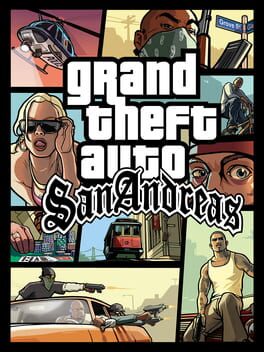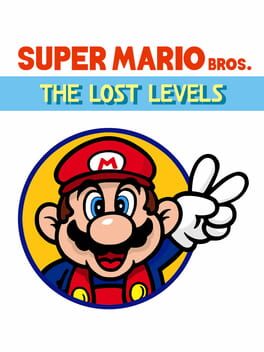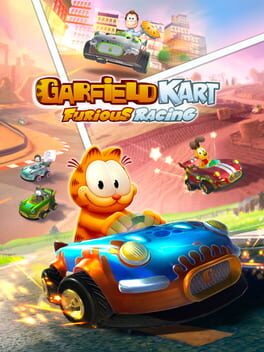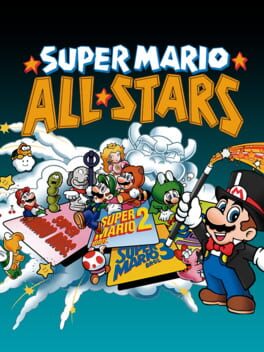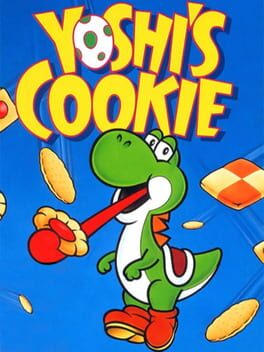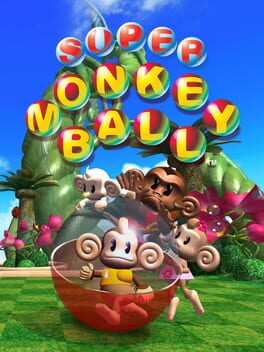where does one even start a review about this game?
at the time of writing this review, i have over fifty hours of gameplay in this game, and i have just completed all the story missions. yet, according to the game, i'm only a little bit over halfway done with everything there is to do in this game. how the hell did they put so much content in a 2004 game?
GTA:SA is so many things at once
firstly, it's a driving simulator of 212 individual vehicles: various cars, bicycles, motorcycles, boats, aeroplanes, trucks with or without trailers, harvesters, tractors, tanks, helicopters, so on and so forth... each vehicle has its own personality and feel, and feels different to drive.
it's an excellent single-player FPS, which often feels very similar to games like Goldeneye 007. the firearms feel great and shoot out missions can be very challenging, requiring great strategy, practice and planning
it's an endless adventure game. the giant map has so much to see and discover that, even with dozens of hours in the game, you continuously find new stuff you've never seen before
it's an open-world game. you can do whatever the hell you want and you genuinely feel like you're even more than the main character.
it has phenomenal writing and some of the greatest cutscenes i've had the chance to watch in gaming. the game is written much like an extravagant hollywood action film, and with how self-aware it is, it succeeds at doing that much better than a vast majority of hollywood films. each character has an immense depth, sensibilities and the player gets attached. let me just say that the ending left me completely jawdropped.
it is such a perfect satire of everything that is wrong with american society, and while its absurdism gives it a certain step back from reality, now that i've visited some of the worst ghettos in the american south, and the more knowledgeable i get about american culture and politics, i feel like GTA:SA got a whole lot right about sociocultural issues in america.
it's truly a masterpiece. it's challenging, it makes you think, and it is phenomenally written. a must play. will definitely get through the rest of this game to 100% it.
at the time of writing this review, i have over fifty hours of gameplay in this game, and i have just completed all the story missions. yet, according to the game, i'm only a little bit over halfway done with everything there is to do in this game. how the hell did they put so much content in a 2004 game?
GTA:SA is so many things at once
firstly, it's a driving simulator of 212 individual vehicles: various cars, bicycles, motorcycles, boats, aeroplanes, trucks with or without trailers, harvesters, tractors, tanks, helicopters, so on and so forth... each vehicle has its own personality and feel, and feels different to drive.
it's an excellent single-player FPS, which often feels very similar to games like Goldeneye 007. the firearms feel great and shoot out missions can be very challenging, requiring great strategy, practice and planning
it's an endless adventure game. the giant map has so much to see and discover that, even with dozens of hours in the game, you continuously find new stuff you've never seen before
it's an open-world game. you can do whatever the hell you want and you genuinely feel like you're even more than the main character.
it has phenomenal writing and some of the greatest cutscenes i've had the chance to watch in gaming. the game is written much like an extravagant hollywood action film, and with how self-aware it is, it succeeds at doing that much better than a vast majority of hollywood films. each character has an immense depth, sensibilities and the player gets attached. let me just say that the ending left me completely jawdropped.
it is such a perfect satire of everything that is wrong with american society, and while its absurdism gives it a certain step back from reality, now that i've visited some of the worst ghettos in the american south, and the more knowledgeable i get about american culture and politics, i feel like GTA:SA got a whole lot right about sociocultural issues in america.
it's truly a masterpiece. it's challenging, it makes you think, and it is phenomenally written. a must play. will definitely get through the rest of this game to 100% it.
1998
This review contains spoilers
A few notes about this game:
- It is definitely one of the 3D platformers with the tightest control in its era, at least with Banjo and Kazooie's base move set. The tech in this game and its heavier platforming sections can be very complex and satisfying. Depsite that, it really lags behind SM64 in numerous aspects, particularly in what regards missed inputs. Some moves, such as backflips and talon trots have heavy cutscenes where the playable characters are stuck and can't do anything. This slows down platforming and makes you feel like you have less control than you should over the characters.
- It is an excellent collect-a-thon and, despite its very high amount of collectibles, has much less filler content than similar games in the genre, such as Donkey Kong 64 and Super Mario Odyssey. I appreciated the focus on exploration and level design rather than mini-games and overly hiden collectibles. This made the game feel very engaging and complete, without much filler.
- The implementation of lives, and the fact that you lose all your notes and Jinjos when you die, made some sections feel like a chore. Nothing's worse than backtracking where you've already been to find notes you had already found before. This makes it even worse when you consider that some notes require items such as gold feathers, which you must gear up on before entering a stage. If you enter a level without the required amount of feathers or eggs to get all of the notes, chances are you'll get stuck and you'll have to start the level all over again, at least to get the 100 notes. Furthermore, there is no easy way before the final boss (if you've already gotten almost all notes in the game) to completely easily fill up your eggs and feathers. You'll be farming these a lot if you're not conservative with them.
- Flying and swimming are two excruciatingly unresponsive move sets, especially when you consider that the air meter is very tight and that you require red feathers to fly. The B-attack when flying is particularly bad, and made the final boss fight especially frustrating, because there is no easy way to fill up your red feathers, only blue eggs and gold feathers. Swimming in Rusty Rocket Bay was awful, too.
- Like other Rareware titles from that era, it is very aesthetically pleasing and is very well written. It looks a whole generation ahead of SM64 graphically despite being released only two years after, and Grant Kirkhope's soundtrack is one of the most unforgettable I've heard. Its dialogue is hilarious and absurd for an E-rated game. I especially fell in love with Kazooie's deadpan disrespect of everything around her, and Brentilda's hilarious aunt energy when she shamelessly spills rumours about her sister. As always, Rareware makes incredible cutscenes and the game felt immensely cinematic because of that.
Despite obvious flaws by today's standards, Banjo-Kazooie is still a classic that is worth playing and has a lot of things going for it.
- It is definitely one of the 3D platformers with the tightest control in its era, at least with Banjo and Kazooie's base move set. The tech in this game and its heavier platforming sections can be very complex and satisfying. Depsite that, it really lags behind SM64 in numerous aspects, particularly in what regards missed inputs. Some moves, such as backflips and talon trots have heavy cutscenes where the playable characters are stuck and can't do anything. This slows down platforming and makes you feel like you have less control than you should over the characters.
- It is an excellent collect-a-thon and, despite its very high amount of collectibles, has much less filler content than similar games in the genre, such as Donkey Kong 64 and Super Mario Odyssey. I appreciated the focus on exploration and level design rather than mini-games and overly hiden collectibles. This made the game feel very engaging and complete, without much filler.
- The implementation of lives, and the fact that you lose all your notes and Jinjos when you die, made some sections feel like a chore. Nothing's worse than backtracking where you've already been to find notes you had already found before. This makes it even worse when you consider that some notes require items such as gold feathers, which you must gear up on before entering a stage. If you enter a level without the required amount of feathers or eggs to get all of the notes, chances are you'll get stuck and you'll have to start the level all over again, at least to get the 100 notes. Furthermore, there is no easy way before the final boss (if you've already gotten almost all notes in the game) to completely easily fill up your eggs and feathers. You'll be farming these a lot if you're not conservative with them.
- Flying and swimming are two excruciatingly unresponsive move sets, especially when you consider that the air meter is very tight and that you require red feathers to fly. The B-attack when flying is particularly bad, and made the final boss fight especially frustrating, because there is no easy way to fill up your red feathers, only blue eggs and gold feathers. Swimming in Rusty Rocket Bay was awful, too.
- Like other Rareware titles from that era, it is very aesthetically pleasing and is very well written. It looks a whole generation ahead of SM64 graphically despite being released only two years after, and Grant Kirkhope's soundtrack is one of the most unforgettable I've heard. Its dialogue is hilarious and absurd for an E-rated game. I especially fell in love with Kazooie's deadpan disrespect of everything around her, and Brentilda's hilarious aunt energy when she shamelessly spills rumours about her sister. As always, Rareware makes incredible cutscenes and the game felt immensely cinematic because of that.
Despite obvious flaws by today's standards, Banjo-Kazooie is still a classic that is worth playing and has a lot of things going for it.
2008
The absolute finest and wildest multiplayer game I've ever played. Comes with 16 new unforgettable tracks, 16 beautiful remasters of old Mario Kart tracks, accompanied by one of the greatest Nintendo soundtracks. The mechanics of this game are the most complex of any Mario Kart game, giving this game virtually no skill ceiling. Online multiplayer, despite the official one being shut down, is getting more and more fun and active through Wiimmfi. The modding scene and custom tracks for this game are unlike anything I've ever seen. One of the most difficult but rewarding games to master. Playing this game online brings me some of the most addicting, frustrating and satisfying feelings ever. A true test of your quick decision making. A true adrenaline pump. Masterpiece.
1989
A short, cute and bizarre 2D Mario game, with unique scenery and artstyle. The game is short and very barebones, with wonky controls and bad hit boxes, but being one of the first handheld game cartridges released in the history of gaming, it fulfills its role very well. The shooter sections are amazing and turn Mario into a sort of Space Invaders type of game. There's only twelve easy levels and you get used to the weird controls very fast; try it out if you haven't.
For a game that is so notoriously difficult, it's disappointing to see how much of its difficulty stems in pseudo-difficulty: pick-a-path, find this hidden block, guess what the right decision is before the screen scrolls too far... once you know the layout of these levels, it's really not too hard, and is just an awkward experimental version of SMB1.
I really liked World 9, so I'd love to play the four bonus worlds, but I seriously can't be bothered beating this thing eight times in a row. So it'll likely stay as is.
I'm glad we got Doki Doki Panic instead of this in the West.
I really liked World 9, so I'd love to play the four bonus worlds, but I seriously can't be bothered beating this thing eight times in a row. So it'll likely stay as is.
I'm glad we got Doki Doki Panic instead of this in the West.
1990
Likely the peak of 2D Mario excellence. Excellent and engaging level design, gorgeous and colorful sprites, lots of great content, especially in the post game, and an unforgettable soundtrack. Finding all 96 exits is an exciting and challenging endeavour. The switch to the new system adds saving and much more powerful cartridges, letting Nintendo masterfully execute all the ideas they had in mind while letting the player beat the game at their own pace. This game shows the potential of the SNES had as a gaming system, the amount of creativity the esceptional team had. Funny, gorgeous, grand and immensely fun. One of the great masterpieces of gaming and the ultimate bridge between the 80's and the 90's.
1986
It has to be appreciated for its historic value; this is not only the very first cartridge in video gaming history to include a battery save--a feature we take for granted nowadays--but it's also a phenomenal adventure game with a complex storyline and a captivating atmosphere, at least for 1986 standards. Let's just say we're light years ahead of Adventure on the Atari 2600 in that regard. Miyamoto indeed successfully managed to emulate the grandiose childlike feeling of natural exploration and it feels like you've never truly found everything that the map has to offer.
The screens perpetually get filled with challenging enemies that have some of the most complex battle styles and advanced AI I've seen in that era of video gaming. It requires a lot of strategy to just clear some of these screens. The frequent "fight or flight response" feelings that this game brings upon the player makes me see it as the first great shift away from traditional mindless fighting styles (shooter/jump on top of the enemy), and therefore, in a way, this game is the grandfather of all RPGs in the way that it brought upon complex enemies, numerous different items and weapons, as well as experimental battle styles.
However, despite how much we owe to this game, it goes without saying that it has aged considerably. Firstly, it's an excessively cryptic game. The Legend of Zelda is practically impossible to complete without some sort of strategy guide. The map that comes printed in the manual is practically useless in terms of progressing through the game. An authentic playthrough would at least require hours of scavenging every single screen in the map, of walking back and forth between screens with the horrendous candle that can only be used once per screen transition (who thought this was a good idea?) and wasting bombs, which are a very scarce commodity, trying to blow up unmarked walls. A game that requires further reading in a book or on the web to complete will inherently leave a sour feeling in my mouth. Titles like Castlevania II and Milon's Secret Castle are often harshly criticized for the very same type of cryptic secrets that are required to make progress through the story. Yet, Zelda, in all its praise, is guilty of the same crimes.
Furthermore, I was disappointed in how some of those dungeons are designed. Having to perpetually and arbitrarily light up some the rooms is tedious and redundant. Enemies like Darknuts and Wizzrobes are some of the most annoying I've ever had to deal with. If Like Likes touch you, they destroy your Magic Shield, which is one of the most expensive items in the game. This annoyed me to no end. Some of the rooms are so saturated with random enemies that there are framerate issues with the original NES. Bosses are reused between dungeons. A bit more thought could have been put in how these dungeons are designed.
So, is NES Zelda still worth playing? Most definitely if you have interest in retro gaming or video gaming history, but otherwise, you can probably skip that one. I got a fair bit of enjoyment out of it but it's most definitely an aging game. I might come back for the second quest at some point if I'm brave enough.
The screens perpetually get filled with challenging enemies that have some of the most complex battle styles and advanced AI I've seen in that era of video gaming. It requires a lot of strategy to just clear some of these screens. The frequent "fight or flight response" feelings that this game brings upon the player makes me see it as the first great shift away from traditional mindless fighting styles (shooter/jump on top of the enemy), and therefore, in a way, this game is the grandfather of all RPGs in the way that it brought upon complex enemies, numerous different items and weapons, as well as experimental battle styles.
However, despite how much we owe to this game, it goes without saying that it has aged considerably. Firstly, it's an excessively cryptic game. The Legend of Zelda is practically impossible to complete without some sort of strategy guide. The map that comes printed in the manual is practically useless in terms of progressing through the game. An authentic playthrough would at least require hours of scavenging every single screen in the map, of walking back and forth between screens with the horrendous candle that can only be used once per screen transition (who thought this was a good idea?) and wasting bombs, which are a very scarce commodity, trying to blow up unmarked walls. A game that requires further reading in a book or on the web to complete will inherently leave a sour feeling in my mouth. Titles like Castlevania II and Milon's Secret Castle are often harshly criticized for the very same type of cryptic secrets that are required to make progress through the story. Yet, Zelda, in all its praise, is guilty of the same crimes.
Furthermore, I was disappointed in how some of those dungeons are designed. Having to perpetually and arbitrarily light up some the rooms is tedious and redundant. Enemies like Darknuts and Wizzrobes are some of the most annoying I've ever had to deal with. If Like Likes touch you, they destroy your Magic Shield, which is one of the most expensive items in the game. This annoyed me to no end. Some of the rooms are so saturated with random enemies that there are framerate issues with the original NES. Bosses are reused between dungeons. A bit more thought could have been put in how these dungeons are designed.
So, is NES Zelda still worth playing? Most definitely if you have interest in retro gaming or video gaming history, but otherwise, you can probably skip that one. I got a fair bit of enjoyment out of it but it's most definitely an aging game. I might come back for the second quest at some point if I'm brave enough.
2007
Casually, the greatest 3D Mario game.
The "gravity/planets" gimmick is done exceptionally well and surprisingly has very little problems with camera glitches, and doesn't get old. Level design feels perpetually unique and grand. Controls are exceptionally responsive, especially when playing on Wiimote and Nunchuck. The motion-controlled spin attack is very responsive and complex. By holding A or not, and spinning with one or the other controller, different heights can be reached, with various different response times. The skill ceiling for this game is very high, making it one of the most interesting emerging speedrunning scenes.
Being the first linear game of the series, for the average player, the goals of each mission is clear and simple. This allows the game to focus on gorgeous cutscenes, cinematics, camera angles, and allows the player to explore individual planets rather than a large open space (with the exception of some levels, namely Beach Bowl and Honeyhive).
The 64/Sunshine-esque "open world" aspect is not totally lost, though. The Purple Comet missions allow for a revisit of each level which feels not too distant from 64's 100-coins missions and Sunshine's blue coins, while having less of a chance of getting lost or being unable to find coins.
Despite being a linear game, Galaxy promotes exploration by allowing players to go for highest coin counts for each mission, by hiding secret stars in levels, as well as having tons of hidden places to find starbits. Unlike other linear 3D Mario games, such as 3D World or 3D Land, Galaxy lets the player explore the level without getting lost, yielding a perpetual engaging experience unlike anything else in the series.
The atmosphere of Super Mario Galaxy has been talked about to death, with good reason. The Mario Galaxy Orchestra's performances of Yokota and Kondo's music never fail to make each level so much more engaging. The cutscenes and camera angles feel meticulously handpicked by cinematic experts.
Exceptionally for a Mario game, the surprisingly complex storyline and Rosalina's character answer metaphysical questions about the series, and ask questions about love, family and death.
Possibly Nintendo's greatest and most complete Mario accomplishment. No filler, just complete engagement from the player throughout the entirety of the one hundred and twenty missions. A staple for 3D platformers and one of the most important games of the last generation.
The "gravity/planets" gimmick is done exceptionally well and surprisingly has very little problems with camera glitches, and doesn't get old. Level design feels perpetually unique and grand. Controls are exceptionally responsive, especially when playing on Wiimote and Nunchuck. The motion-controlled spin attack is very responsive and complex. By holding A or not, and spinning with one or the other controller, different heights can be reached, with various different response times. The skill ceiling for this game is very high, making it one of the most interesting emerging speedrunning scenes.
Being the first linear game of the series, for the average player, the goals of each mission is clear and simple. This allows the game to focus on gorgeous cutscenes, cinematics, camera angles, and allows the player to explore individual planets rather than a large open space (with the exception of some levels, namely Beach Bowl and Honeyhive).
The 64/Sunshine-esque "open world" aspect is not totally lost, though. The Purple Comet missions allow for a revisit of each level which feels not too distant from 64's 100-coins missions and Sunshine's blue coins, while having less of a chance of getting lost or being unable to find coins.
Despite being a linear game, Galaxy promotes exploration by allowing players to go for highest coin counts for each mission, by hiding secret stars in levels, as well as having tons of hidden places to find starbits. Unlike other linear 3D Mario games, such as 3D World or 3D Land, Galaxy lets the player explore the level without getting lost, yielding a perpetual engaging experience unlike anything else in the series.
The atmosphere of Super Mario Galaxy has been talked about to death, with good reason. The Mario Galaxy Orchestra's performances of Yokota and Kondo's music never fail to make each level so much more engaging. The cutscenes and camera angles feel meticulously handpicked by cinematic experts.
Exceptionally for a Mario game, the surprisingly complex storyline and Rosalina's character answer metaphysical questions about the series, and ask questions about love, family and death.
Possibly Nintendo's greatest and most complete Mario accomplishment. No filler, just complete engagement from the player throughout the entirety of the one hundred and twenty missions. A staple for 3D platformers and one of the most important games of the last generation.
Choosing to follow the original Zelda's play style rather than making another Link's Adventure worked incredibly well here. Indeed, A Link to the Past builds on the concepts that were tried out with Zelda 1 and makes just about everything better. The controls are satisfying and there is a huge variety of items are your disposal to try and figure out what the next step is. It just tickles the brain in a certain way that is so satisying; you'll get to a screen where you will have no idea what to do, and you will progressively get more and more of an idea what to do to progress until you actually manage to logically figure it out by yourself. It also shows how desperately top-down Zelda needed a more proper map system than the NES's very primitive one. Everything just works perfectly, it's incredibly difficult, has you thinking a lot, and just feels amazing to progress in. However, some of the puzzles near the end of the game did push my patience in terms of how cryptic they were a bit further than what I was comfortable with; I did use the help of the internet a handful of times for the very rare occasions where this game tries to pull some NES Zelda-type cryptic secret that is required to progress through the game. Furthermore, some of the game design did lead to a fair bit of backtracking and mindless exploration of the overworld with no idea what to do next (even though the hints given by the psychic dude worked pretty well for the most part in figuring out what to do next). My complaints are few and scarce though, this is indeed an amazing SNES game and it makes me excited to play the following installments in the series.
Obviously one of the SNES's most essential releases. Solid revisit of the original Mario tetralogy, with remastered sounds and visuals. A lot of the things that were annoying about the original games (i.e. no battery save, having to beat SMB2J 8 times to unlock worlds A-D) are corrected. However, gameplay wise, the games are very faithful to their original NES and FDS versions. Indeed the definitive way to play these games.
2002
1993
Clear lines of similarly-shaped pieces and they dissapear, while being quick enough to avoid new falling pieces. It really is everything you should expect from Bullet-Proof Software: it's a well-presented, easy to pick up and addicting Tetris-style puzzle game. Sprite work is very solid and the atmosphere kept me engaged until the very end. Regular game isn't too hard, containing 100 stages which were pretty easy but fun for me to play through.
Cartridge also contains split-screen multiplayer (which I have yet to try) and a Puzzle mode in which you have to clear a preexisting set of lines in a maximum amount of moves. There are 100 of these puzzles, and they were designed by Tetris creator Alexei Pazhitnov. Don't really feel like playing these for the time being, but if I ever want to get better at the main game (to speedrun or whatever), then those puzzles could help me get better at the game.
Regardless, it has a lot to do and has very fine replayability. Worth obtaining.
Cartridge also contains split-screen multiplayer (which I have yet to try) and a Puzzle mode in which you have to clear a preexisting set of lines in a maximum amount of moves. There are 100 of these puzzles, and they were designed by Tetris creator Alexei Pazhitnov. Don't really feel like playing these for the time being, but if I ever want to get better at the main game (to speedrun or whatever), then those puzzles could help me get better at the game.
Regardless, it has a lot to do and has very fine replayability. Worth obtaining.
2001
1996
Imagine playing this when it just came out in 1996. At this point, the entirety of your 3D gaming culture is limited to shooters such as DOOM or Star Fox. If you were an avid gamer, maybe you played the primitive Jumping Flash, but for most, a platforming game that broke into the third dimension was barely imaginable.
First moving Mario in Peach's courtyard must have been a surreal and unbelievable experience for the gamers who had the chance to live this exceptional era. Learning to move Mario with your 360-degree joystick, moving the camera with the C and R buttons, learning to sideflip, backflip, triple jump, wall kick with the game's exceptionally responsive control scheme is a truly unique experience for new players even nowadays.
As a matter of fact, no other Mario game (except, maybe, SMW if you consider 2D games) has ever had controls this responsive and complex. I've been playing this game on and off since 2013, and speedrunning it since 2017, and I always find myself impressed by its advanced tech: speed kicks, slide controls, backwards long jumps, dustless movement and lag reduction add so much to the game which which has virtually no skill ceiling. How the hell did they do it so well for their first ever 3D game effort?
The camera is a common point of criticism by unexperienced players, which is understandable; the camera controls aren't communicated well with the player. However, when one learns to master all different camera modes, the camera feels excessively responsive and free, and you will face very few awkward situations, even less than in modern 3D Mario games with more fixed camera angles.
The core game's levels feel somewhat unfinished, which is the only thing keeping me from giving this a perfect score. Don't get me wrong: levels like Tick Tock Clock, Bob Omb Battlefield and Hazy Maze Cave are some of the most creative and beautiful level designs I've seen in 3D gaming and it still stands very well to this day. However, some of the levels feel limited and a large part of the castle is uncannily empty, with very few enterable paintings in contrast to empty ones. I've heard that the game was initially supposed to have twice the amount of stages, but they had to cut down due to time limitations (can't find a source that proves that but I believe it). As a result, the levels can feel as if corners were cut, and will maybe leave you desiring for more. The incredible and perpetually growing ROM Hacking scene of the game can leave you entertained and fill this longing for new and more complex levels. Kaze Emanuar's incredible console compatible ROM hacks push the limits of what is possible with the Nintendo 64 and with the game per se. This game unintendedly grew to have one of the most amazing modding scenes in all of gaming, with thousands of creators making new levels, retextures and gameplay updates for the game. Somehow, anything is possible in this game. Avid gamers even managed to reverse engineer the entire source code of the game, making this one of the most well-understood video games ever.
Still, the vanilla game holds no boring missions and will print itself in your memories with some of its unforgettable moments. There are so many ways to play this, even with an unmodified game cartridge.
I strongly recommend playing this on original Nintendo 64 hardware. Playing this the authentic way with either an OEM controller or a Hori Mini Pad on a CRT television is one of the finest gaming experiences one can live. Still, Emulator (Mupen and Project 64 especially) and Wii VC stand up very well. Just have some respect for yourself and don't play on Wii U or Switch.
It is inexplicable how influent this game is in the world of gaming. All 3D platformers and a vast majority of third person 3D games owe their success to the developments of SM64 in movement schemes and camera controls.
First moving Mario in Peach's courtyard must have been a surreal and unbelievable experience for the gamers who had the chance to live this exceptional era. Learning to move Mario with your 360-degree joystick, moving the camera with the C and R buttons, learning to sideflip, backflip, triple jump, wall kick with the game's exceptionally responsive control scheme is a truly unique experience for new players even nowadays.
As a matter of fact, no other Mario game (except, maybe, SMW if you consider 2D games) has ever had controls this responsive and complex. I've been playing this game on and off since 2013, and speedrunning it since 2017, and I always find myself impressed by its advanced tech: speed kicks, slide controls, backwards long jumps, dustless movement and lag reduction add so much to the game which which has virtually no skill ceiling. How the hell did they do it so well for their first ever 3D game effort?
The camera is a common point of criticism by unexperienced players, which is understandable; the camera controls aren't communicated well with the player. However, when one learns to master all different camera modes, the camera feels excessively responsive and free, and you will face very few awkward situations, even less than in modern 3D Mario games with more fixed camera angles.
The core game's levels feel somewhat unfinished, which is the only thing keeping me from giving this a perfect score. Don't get me wrong: levels like Tick Tock Clock, Bob Omb Battlefield and Hazy Maze Cave are some of the most creative and beautiful level designs I've seen in 3D gaming and it still stands very well to this day. However, some of the levels feel limited and a large part of the castle is uncannily empty, with very few enterable paintings in contrast to empty ones. I've heard that the game was initially supposed to have twice the amount of stages, but they had to cut down due to time limitations (can't find a source that proves that but I believe it). As a result, the levels can feel as if corners were cut, and will maybe leave you desiring for more. The incredible and perpetually growing ROM Hacking scene of the game can leave you entertained and fill this longing for new and more complex levels. Kaze Emanuar's incredible console compatible ROM hacks push the limits of what is possible with the Nintendo 64 and with the game per se. This game unintendedly grew to have one of the most amazing modding scenes in all of gaming, with thousands of creators making new levels, retextures and gameplay updates for the game. Somehow, anything is possible in this game. Avid gamers even managed to reverse engineer the entire source code of the game, making this one of the most well-understood video games ever.
Still, the vanilla game holds no boring missions and will print itself in your memories with some of its unforgettable moments. There are so many ways to play this, even with an unmodified game cartridge.
I strongly recommend playing this on original Nintendo 64 hardware. Playing this the authentic way with either an OEM controller or a Hori Mini Pad on a CRT television is one of the finest gaming experiences one can live. Still, Emulator (Mupen and Project 64 especially) and Wii VC stand up very well. Just have some respect for yourself and don't play on Wii U or Switch.
It is inexplicable how influent this game is in the world of gaming. All 3D platformers and a vast majority of third person 3D games owe their success to the developments of SM64 in movement schemes and camera controls.
